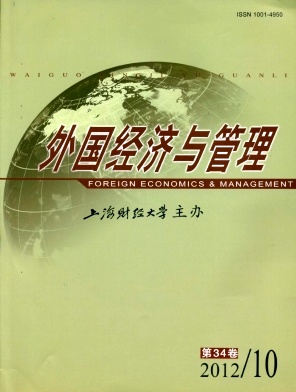“特质”与“状态”:内涵、联系与启示——基于积极组织视角
外国经济与管理 2012 年 第 34 卷第 10 期, 页码:39 - 47
摘要
参考文献
摘要
在积极心理运动的推动下,人的优势能力开始受到前所未有的关注和重视。源于人格心理学的两个概念——"特质"与"状态"也被赋予"积极"色彩,被视为组织中积极能量的两个重要来源,成为积极组织研究和管理领域的重要概念。本文梳理了人格心理学和组织行为领域关于"特质"与"状态"的研究成果,从积极组织视角对个体"特质"与"状态"的本质与内涵演变、两者关系、意义与启示等问题进行了深入探讨,并对未来研究方向进行了展望。
[1]Allen B P and Potkay C R.On the arbitrary distinction be-tween states and traits[J].Journal of Personality and Social Psychology,1981,41(5):916-928.
[2]Allport G W and Odbert H S.Trait names:A psycho-lexical study[J].Psychological Monographs,1936,47(1):1-93.
[3]Allport G W.Pattern and growth in personality[M].New York:Holt,Rinehart&Winston,1961.
[4]Anderson L M,et al.On the relationship of hope and gratitude to corporate social responsibility[J].Journal of Business Ethics,2007,70(4):401-409.
[5]Ashkanasy N M and Daus C S.Emotion in the workplace:The new challenge for managers[J].Academy of Management Executive,2002,16(1):76-86.
[6]Barrick M R and Mount M K.The Big Five personality dimen-sions and job performance:A meta-analysis[J].Personnel Psy-chology,1991,44(1):1-26.
[7]Best R G,et al.Core self-evaluations and job burnout:The test of alternative models[J].Journal of Occupational Health Psy-chology,2005,10(4):441-451.
[8]Cameron K,et al.Positive organizational scholarship:Founda-tions of a new discipline[M].San Francisco:Berrett-Koehler,2003.
[9]Forgays D G,et al.Factor structure of the state-trait anger ex-pression inventory[J].Journal of Personality Assessment,1997,69(3):497-507.
[10]Fredrickson B L,et al.Open hearts build lives:Positive emo-tions,induced through loving-kindness meditation,build con-sequential personal resources[J].Journal of Personality&Social Psychology,2008,95(5):1045-1062.
[11]George J M.State or trait:Effects of positive mood on proso-cial behaviors at work[J].Journal of Applied Psychology,1991,76(2):299-307.
[12]Ilies R,et al.The interactive effects of personal traits and ex-perienced states on intraindividual patterns of citizenship be-havior[J].Academy of Management Journal,2006,49(3):561-575.
[13]Judge T A,et al.The dispositional causes of job satisfaction:A core evaluations approach[A].Cummings L and Staw B(Eds.).Research in organizational behavior[C].Greenwich,CT:JAI Press,1997,19:151-188.
[14]Kelloway E K.Positive organizational scholarship[J].Cana-dian Journal of Administrative Sciences,2011,28(1):1-3.
[15]Kluemper D H,et al.State or trait:Effects of state optimism on job-related outcomes[J].Journal of Organizational Beha-vior,2009,30(2):209-231.
[16]Luthans F.The need for and meaning of positive organiza-tional behavior[J].Journal of Organizational Behavior,2002,23(6):695-706.
[17]Luthans F and Youssef C M.Human,social and now positive psychological capital management:Investing in people for competitive advantage[J].Organizational Dynamics,2004,33(2):143-160.
[18]Luthans F and Youssef C M.Emerging positive organizational behavior[J].Journal of Management,2007,33(3):321-349.
[19]Luthans F,et al.Psychological capital:Developing the human competitive edge[M].Oxford,UK:Oxford University Press,2007.
[20]Mischel W.Personality and assessment[M].New York:Wi-ley,1968.
[21]Ozer D J and Benet V.Personality and the prediction of con-sequential outcomes[J].Annual Review of Psychology,2006,57(1):410-421.
[22]Peterson S J,et al.Psychological capital and employee per-formance:A latent growth modeling approach[J].Personnel Psychology,2011,64(2):427-450.
[23]Seligman M E P and Csikszentmihalyi M.Positive psycho-logy:An introduction[J].American Psychologist,2000,55(1):5-14.
[24]Seligman M E P,et al.Positive psychology progress[J].A-merican Psychologist,2005,60(5):410-421.
[25]Snyder C R.Handbook of hope[M].San Diego,CA:Acade-mic Press,2000.
[26]Walumbwa F O,et al.Authentically leading groups:The me-diating role of positivity and trust[J].Journal of Organiza-tional Behavior,2011,32(1):4-24.
[27]Wright T A.Time revisited in organizational behavior[J].Journal of Organizational Behavior,1997,18(3):201-204.
[28]Wright T A and Quick J C.The role of positive-based re-search in building the science of organizational behavior[J].Journal of Organizational Behavior,2009,30(2):329-336.
[29]Zuckerman M.The distinction between trait and state scales is not arbitrary:Comment on Allen and Potkay’s“on the ar-bitrary distinction between states and traits”[J].Journal of Personality and Social Psychology,1983,44(5):1083-1086.
[30]胡光涛等.执行维稳任务军人个性、应对方式、状态—特质焦虑与心理健康的相关性研究[J].第三军医大学学报,2010,32(19):2118-2120.
[31]刘惠军,高红梅.状态特质愤怒表达量表修订版在大学生中的信效度[J].中国心理卫生杂志,2012,26(1):70-76.
[32]罗霞,陈维政.组织管理研究的新领域———积极组织管理[J].经济管理,2009,31(10):174-178.
[2]Allport G W and Odbert H S.Trait names:A psycho-lexical study[J].Psychological Monographs,1936,47(1):1-93.
[3]Allport G W.Pattern and growth in personality[M].New York:Holt,Rinehart&Winston,1961.
[4]Anderson L M,et al.On the relationship of hope and gratitude to corporate social responsibility[J].Journal of Business Ethics,2007,70(4):401-409.
[5]Ashkanasy N M and Daus C S.Emotion in the workplace:The new challenge for managers[J].Academy of Management Executive,2002,16(1):76-86.
[6]Barrick M R and Mount M K.The Big Five personality dimen-sions and job performance:A meta-analysis[J].Personnel Psy-chology,1991,44(1):1-26.
[7]Best R G,et al.Core self-evaluations and job burnout:The test of alternative models[J].Journal of Occupational Health Psy-chology,2005,10(4):441-451.
[8]Cameron K,et al.Positive organizational scholarship:Founda-tions of a new discipline[M].San Francisco:Berrett-Koehler,2003.
[9]Forgays D G,et al.Factor structure of the state-trait anger ex-pression inventory[J].Journal of Personality Assessment,1997,69(3):497-507.
[10]Fredrickson B L,et al.Open hearts build lives:Positive emo-tions,induced through loving-kindness meditation,build con-sequential personal resources[J].Journal of Personality&Social Psychology,2008,95(5):1045-1062.
[11]George J M.State or trait:Effects of positive mood on proso-cial behaviors at work[J].Journal of Applied Psychology,1991,76(2):299-307.
[12]Ilies R,et al.The interactive effects of personal traits and ex-perienced states on intraindividual patterns of citizenship be-havior[J].Academy of Management Journal,2006,49(3):561-575.
[13]Judge T A,et al.The dispositional causes of job satisfaction:A core evaluations approach[A].Cummings L and Staw B(Eds.).Research in organizational behavior[C].Greenwich,CT:JAI Press,1997,19:151-188.
[14]Kelloway E K.Positive organizational scholarship[J].Cana-dian Journal of Administrative Sciences,2011,28(1):1-3.
[15]Kluemper D H,et al.State or trait:Effects of state optimism on job-related outcomes[J].Journal of Organizational Beha-vior,2009,30(2):209-231.
[16]Luthans F.The need for and meaning of positive organiza-tional behavior[J].Journal of Organizational Behavior,2002,23(6):695-706.
[17]Luthans F and Youssef C M.Human,social and now positive psychological capital management:Investing in people for competitive advantage[J].Organizational Dynamics,2004,33(2):143-160.
[18]Luthans F and Youssef C M.Emerging positive organizational behavior[J].Journal of Management,2007,33(3):321-349.
[19]Luthans F,et al.Psychological capital:Developing the human competitive edge[M].Oxford,UK:Oxford University Press,2007.
[20]Mischel W.Personality and assessment[M].New York:Wi-ley,1968.
[21]Ozer D J and Benet V.Personality and the prediction of con-sequential outcomes[J].Annual Review of Psychology,2006,57(1):410-421.
[22]Peterson S J,et al.Psychological capital and employee per-formance:A latent growth modeling approach[J].Personnel Psychology,2011,64(2):427-450.
[23]Seligman M E P and Csikszentmihalyi M.Positive psycho-logy:An introduction[J].American Psychologist,2000,55(1):5-14.
[24]Seligman M E P,et al.Positive psychology progress[J].A-merican Psychologist,2005,60(5):410-421.
[25]Snyder C R.Handbook of hope[M].San Diego,CA:Acade-mic Press,2000.
[26]Walumbwa F O,et al.Authentically leading groups:The me-diating role of positivity and trust[J].Journal of Organiza-tional Behavior,2011,32(1):4-24.
[27]Wright T A.Time revisited in organizational behavior[J].Journal of Organizational Behavior,1997,18(3):201-204.
[28]Wright T A and Quick J C.The role of positive-based re-search in building the science of organizational behavior[J].Journal of Organizational Behavior,2009,30(2):329-336.
[29]Zuckerman M.The distinction between trait and state scales is not arbitrary:Comment on Allen and Potkay’s“on the ar-bitrary distinction between states and traits”[J].Journal of Personality and Social Psychology,1983,44(5):1083-1086.
[30]胡光涛等.执行维稳任务军人个性、应对方式、状态—特质焦虑与心理健康的相关性研究[J].第三军医大学学报,2010,32(19):2118-2120.
[31]刘惠军,高红梅.状态特质愤怒表达量表修订版在大学生中的信效度[J].中国心理卫生杂志,2012,26(1):70-76.
[32]罗霞,陈维政.组织管理研究的新领域———积极组织管理[J].经济管理,2009,31(10):174-178.
引用本文
符纯洁, 凌文辁. “特质”与“状态”:内涵、联系与启示——基于积极组织视角[J]. 外国经济与管理, 2012, 34(10): 39–47.
导出参考文献,格式为:
上一篇:群体交互记忆系统研究述评





 9186
9186  443
443

